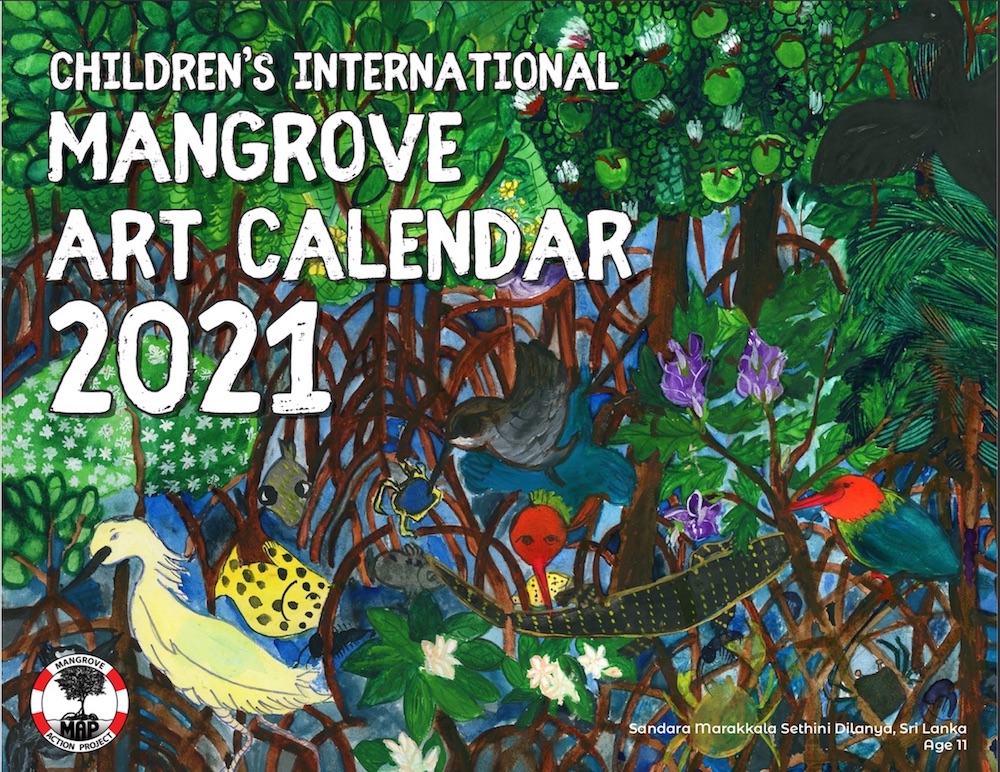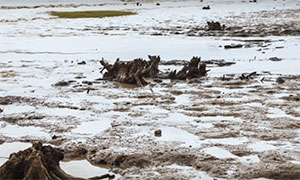|
|
|
|
2021 Children's Mangrove Art Calendars
NOW AVAILABLE
|
|
Mangrove Action ProjectClick here to view past newsletters |
Search News Archive
Monday, November 30, 2020
2021 Children's Mangrove Art Calendars NOW AVAILABLE
Saturday, November 21, 2020
MAP News Issue #508 - Nov 21, 2020
|
The MAP News
508th Edition Nov 21, 2020 |
|
|
Mangrove Rangers advocate for the ‘Heart of Cayman’ 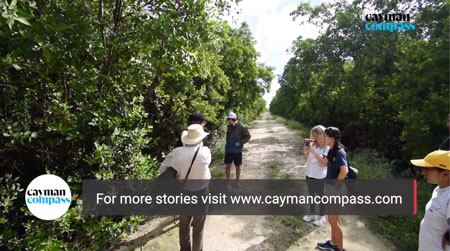 CAYMAN ISLANDS - A small but growing group of volunteers is working to protect and preserve ‘the heart of Cayman’ – the mangroves that provide the islands storm protection, habitat for native species and weather regulation. Mangrove forests are one of the most valuable coastal ecosystems on the planet offering many natural services that protect humanity’s best interest. However, these ecosystems are depleting rapidly, thus contributing to ecological degradation due to climate change and over development. Since 1970, We have lost 3,900 acres of pristine mangrove forests in the western area of Grand Cayman. With only 1,500 acres of mangroves left (38%! in this area, we have decided enough is enough and as we fight to protect this important ecosystem. In addition, the 8,500 acre Central Mangrove Wetlands - the largest contiguous mangrove forest in the Caribbean - is under serious threat of development. Conservation requires an array of skills hence why our Rangers come from diverse backgrounds from marketing, law, hospitality to videography, and education. All of our Rangers are knowledgeable on the scientific functions of mangrove ecosystems in addition to their specialty. We value teamwork and the elevation of individual aspirations. We aim to develop each other weaknesses and utilize each other strengths as we protect this valuable natural resource. We aim to educate and enable students, teachers, parents, and their communities in the understanding and monitoring of the wonderful world of mangroves in the Cayman Islands. We achieve this through, observation, outreach data collection and advocacy. We continue to establish a conservation ethos to protect and enhance mangrove ecosystems. VIEW VIDEO GLOBAL Art to save the mangroves : a key to climate change 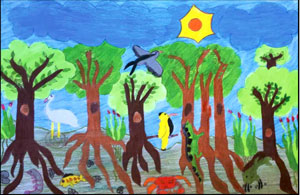 GLOBAL: “Close your eyes and imagine some wetlands with magical trees, with huge roots emerging from a gray, half-swampy soil. A place that is right where fresh water and salt water meet: in which there are canals to navigate, manatees, crocodiles, monkeys and many species of birds. Those are the mangroves ”. This is the way Mónica Gutiérrez Quarto, a Chilean artist who now lives in the United States, describes one of the ecosystems to which she has dedicated part of her work. As a member of the Mangrove Action Project (MAP) team, an initiative founded by her husband Alfredo Quarto, she uses art to educate boys and girls around the world about mangroves: one of the most important forests for climate change. In fact, according to the Convention on Wetlands, known as the Ramsar Convention, mangroves and associated wetlands account for almost a third of the world's terrestrial carbon stocks. That makes them key to fighting climate change. But like many ecosystems, mangroves are under threat. Alfredo learned about this several years ago when he traveled to southern Thailand and learned about the problem first-hand. There, as in other parts of the world, shrimp farms were being installed, which not only affected the ecosystem, but also threatened the communities that live off them and had been opposing these projects. Since then his mission, together with MAP, has been to work to reforest and restore them. But they do not do it in a conventional way, simply by planting the trees and their seeds, but by involving the community. A method that, according to Quarto, has proven to be more effective. READ MORE (en Español) 4 Opportunities to Shore Up the World's Coastal Ecosystems  GLOBAL - For the more than 3 billion people who live near the ocean, coastal ecosystems support jobs, industries and trade, as well as provide food and buffering against storms and other severe natural events. Yet, these vital areas are at risk as rising populations and growing urbanization prompt the significant loss and damage of coastal habitats — including saltmarshes, mangroves, coral reefs and shellfish reefs. These losses reduce coastal resilience, as well as our ability to recover and adapt to climate change and other human-caused threats. To change this trajectory, a new paper commissioned by the High Level Panel for a Sustainable Ocean Economy proposes a new way forward with four opportunities for action to ensure sustainable and resilient coastal zones. READ MORE Public Perceptions of Mangrove Forests Matter for Their Conservation 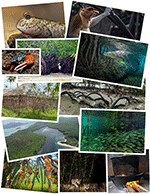 GLOBAL - Iconic species and landscapes attract public attention to help reverse the degradation of ecosystems and their biodiversity; sharing their images on social media can act as a powerful way to influence perceptions and drive positive actions by the public. Social media platforms such as Twitter, Facebook and Instagram have been used to great effect to communicate the urgency required to halt and reverse tropical forest loss and the plight of coral reefs. Ecosystems such as seagrass meadows, mudflats, and mangrove forests receive substantially less media exposure. Despite our improved understanding of the importance of mangrove forests and their ecosystem services, negative perceptions of these wetlands are still common. We highlight the dangers of recurrent public misperceptions about mangroves and how they can be countered. The authors represent a variety of stakeholders involved in the research and communication of mangrove forests through academia, government agencies and non-governmental organizations involved in conservation. READ MORE AFRICA Mangrove revival: How tree-planting is financing women’s businesses in Kenya  KENYA - Mangrove forests are an essential source of fish, medicines and mosquito repellant to people living on Kenya’s Indian Ocean coastline – as well as providing climate benefits by storing carbon. In Lamu County, the most heavily forested stretch of coast, nearly 40% of the mangrove area has become degraded, driven by unsustainable logging for construction and firewood. Local women are reversing the trend, in a community conservation initiative that combines tree-planting with microfinance. Volunteers have restored 10,000 hectares of forest cover, towards a target of 35,000 hectares in five years, raising revenue through the sale of carbon credits. Some of the proceeds go to a microloan scheme, empowering members to start businesses and overcome poverty. READ MORE AMERICAS Tilting Boat Threatens Massive Oil Spill in Caribbean  Venezuela—A Venezuelan ship carrying more than 1 million barrels of oil is listing in the Caribbean Sea, threatening to create an environmental disaster that could be the region’s worst ever. The storage and offloading vessel is listing to one side in the Gulf of Paria, between the island of Trinidad and Venezuela’s east coast, where it is permanently moored. The vessel, dubbed the Nabarima, is operated by Petrosucre, a joint venture between PDVSA, the Venezuelan state-owned oil company, and Italian multinational Eni, one of the world’s seven “supermajor” oil companies. Environmental groups have expressed concern that the estimated 1.3 million barrels of crude on the vessel could spill into the sea, despite recent reports that a ship-to-ship transfer of the oil is underway. “It appears that a Venezuelan oil tanker, the ICARO, has approached the FSO Nabarima and is transferring some of the oil within, affording an opportunity to assess the listing,” Gary Aboud of Fishermen and Friends of the Sea said in a statement. READ MORE ASIA JICA funding dirty coal in Bangladesh and Indonesia 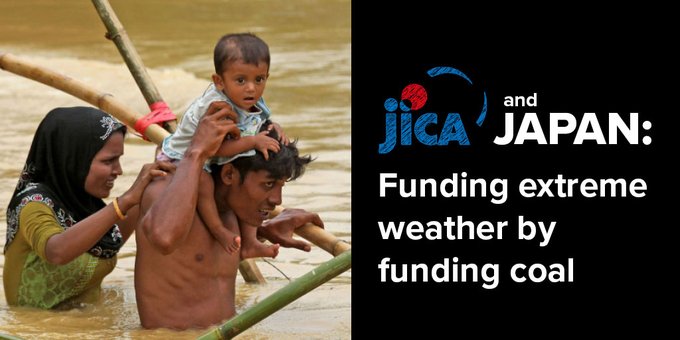 JAPAN - The Japan International Cooperation Agency (JICA), a development agency under the Japanese Ministry of Foreign Affairs, is considering lending funds to build the 1,200 MW Matarbari (Phase 2) coal fired power plant in coastal Bangladesh and Indramayu (Phase 4), a 1,000MW coal power station in Indonesia. JICA is participating in a meeting with other development agencies from around the world discussing climate and other global issues on November 10- 12. This Finance in Common Summit is the perfect time to call them out for their hypocrisy! If built, the coal plants would emit millions of tonnes of carbon into the atmosphere, emissions that will speed up the destruction of our shared climate and contradict Japan’s recent commitment to produce net zero carbon emissions by 2050. The plants will also worsen the air quality and livelihoods of local communities in the area, when these communities are already being hit with air pollution and climate impacts. JICA and the Ministry of Foreign Affairs need to know that the global community isn’t going to stand for them building two polluting power stations and claiming to act on climate. TAKE ACTION A Philippine community sees life-saving payoffs from restoring its mangroves  PHILIPPINES - In December 1989, Elizabeth Ramos, now 63, heard from a neighbor that a mangrove reforestation project was underway near her home in the province of Aklan in the central Philippines. The meeting Ramos joined that day was for a reforestation effort by the Department of Environment and Natural Resources (DENR), which had hired 30 local families to plant 50 hectares (124 acres) of mangroves in the mudflats of the adjoining villages of Old and New Buswang. Ramos was not one of the villagers originally selected to participate in this livelihood scheme, which offered people 75 centavos (then about 4 U.S. cents) per tree planted. But when other participants backed out, Ramos stepped in, ultimately becoming an integral part of a program that would reshape both her life and her community. READ MORE Landless Thais granted homes in mangrove forest  THAILAND - Thai authorities have reached an agreement with a landless community that allows villagers to live in a mangrove forest if they help protect the area, a unique collaboration that could work across the country, land rights groups said. Under a memorandum of understanding (MOU) between the government, human rights groups and about 45 families in the coastal town of Ranong, the community would not get ownership rights, but would receive assistance in building homes and access to utilities. The agreement, which was struck earlier this month and includes indigenous people such as the sea gypsies, is now being replicated in the coastal cities of Phuket and Krabi. “The communities have been fighting for land for a long time and we had been trying to find a solution through numerous negotiations,” said Maitree Jongkraijug, a manager at the Chumchonthai Foundation, a nonprofit that is a part of the MOU. “This is a pilot project, the first of its kind — a model of cooperation between communities, civic organizations and the government that can work for landless people in protected areas,” he told reporters. READ MORE How are villagers of Kakapir saving the mangroves? 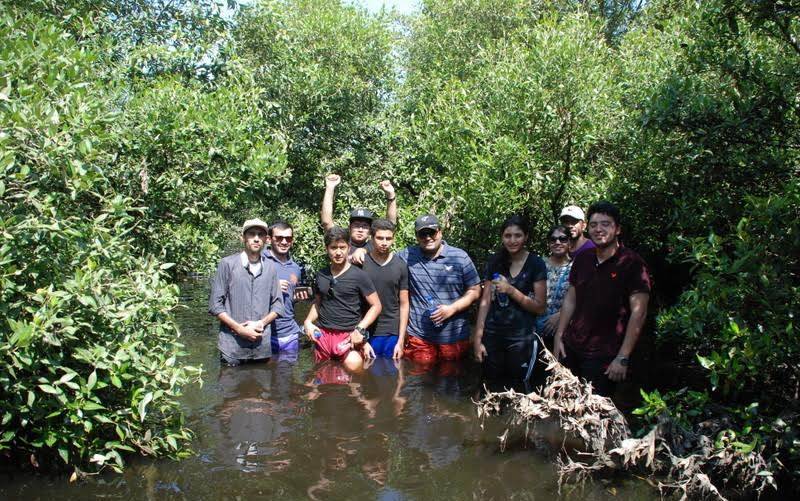 PAKISTAN - Mangroves are one of the most important components of the marine ecosystem. However, their relentless deforestation, together with the dumping of industrial and domestic waste into the sea, have led to the destruction of these eco-friendly plants. Fishermen and their families living in the coastal regions have traditionally been the custodians of mangrove forests. Such is the case of the people of Kakapir, a fishing village in Karachi Harbour, situated 15 kilometres to the west of the metropolis. Speaking to Geo News, Mai Ruqqaiyah, an old woman from Kakapir, said that she protects the trees just like she protects her children. She is one of the many active community members who are working hard for the survival of the mangrove forests. "These forests not only helped us catch prawns and fish but they also mitigated the effects of storms for many years," she said. "Greedy humans, however, destroyed these forests to fill the land and construct buildings." READ MORE Fighting climate change with bamboo  CHINA - Bamboo is a surprisingly effective carbon sink and is being promoted by the government as a uniquely chinese solution to climate change they are synonymous with the giant panda, and a ubiquitous part of life and culture across much of the south. China’s bamboo forests – all 6.8 million hectares of them – could also play an outsized role in the country’s plans to check climate change. Fast-growing, versatile and able to thrive on sloping, degraded soils, giant bamboos have long been considered a valuable source of income – sometimes called “poor man’s timber” – as well as an important tool for stabilising slopes and preventing soil erosion. More recently, bamboo has gained attention alongside tree-planting for its potential role in removing large amounts of carbon dioxide from the atmosphere, which would contribute to keeping global warming below 1.5C. Despite its potential, several issues have hindered bamboo’s take-up as a carbon sink. READ MORE EUROPE Mangrove coverage is declining, but there is hope, flags study  U.K. - Mangroves forests are being threatened at an increasing pace: River dams negatively impact the supply of mud that raises mangrove soils. The space required for their survival is increasingly getting occupied by buildings and seawalls. Tidal barriers have proven to be disastrous for mangrove coverage and can result in species loss. But mangrove coverage can increase despite sea-level rise if sediment supply is sufficient and land accommodation space available, according to a recent study published in Environmental Research Letters November 10, 2020. Mangroves depend on a steady supply of sediment flowing down from rivers. The delivery of sediment from most rivers reduced over the past three decades. Coastal mangrove forests are valuable, highly biodiverse ecosystems that protect coastal communities against storms. A narrow mangrove zone is less effective in protecting the coast against storms; in the worst case, it may lose its protective properties altogether. “Both mangrove coverage loss and diversity loss go hand in hand when that landward retreat is limited by expanding cities, agriculture or flood protection works,” said Barend van Maanen from the University of Exeter and one of the authors of the study. READ MORE VIDEO FEATURE Blue carbon - our oceans are a natural climate solution Our oceans represent one of the biggest opportunities for slowing and reversing climate and ecological breakdown - but they are under continuing threat from over-fishing, dumping of toxic waste and other human impacts. By protecting and restoring the world's oceans, we can help restore the prospects of humanity. WATCH VIDEO HERE Written & Narrated by George Monbiot Design, Direction & Animation: Al Boardman Sound Design: Joe Watkinson My Octopus Teacher A filmmaker forges an unusual friendship with an octopus living in a South African kelp forest, learning as the animal shares the mysteries of her world WATCH VIDEO HERE |
FEATURE ACTION ALERTTell the Japan International Cooperation Agency not to fund polluting coal – TAKE ACTIONMORE ACTION
|
|
Mangrove Action Project Click here to view past newsletters
|
|
Saturday, November 7, 2020
Dear reader: We attempted to include the following story in our newsletter, but the service we use for mass emails blocked it due to the missing SSL certificate on the fao.org's website. We are recreating the page here to use our own SSL ceritifcate and apologize to the FAO for the redirect. We felt this story was important to share. To find the original story please visit http://www.fao.org/fao-stories/article/en/c/1318734/
Cecilia Rivas (middle) is the ‘captain’ of the Kariña community, leading a restoration project in their native Imataca Forest Reserve. ©FAO/Jesús Contreras
It is around five in the morning, and the Imataca Forest Reserve is stirring with the voices of Kariña women. They advance towards the middle of the jungle, bound for the Botanamo river to gather the day’s water. Then, these indigenous women will prepare “casabe”, a circular tortilla made from cassava flour, to accompany what other members of the tribe have brought in from the hunt. After breakfast they turn to their main task of the day: managing and conserving the forest.
“I have never seen my indigenous sisters so motivated, so encouraged by their work… Even with all the problems that our country is going through, these women have the initiative to better their own community,” says Cecilia Rivas, the group’s “captain”.
“Captain” signifies the community’s elected leader. “The Kariña group was always dominated by men. We had neither voice nor vote before,” she explains. Cecilia’s election in 2013 marked the beginning of a transformation. The FAO-GEF project, which also aims to increase gender equality in the forestry sector, has continued this change in thinking, supporting the Kariña women in actively leading the development of their territories and the conservation of the area’s biodiversity.
Community forest management
Imataca is an extensive and hugely diverse, tropical humid forest located in the southeast of Venezuela. The biodiversity of this natural reserve is truly extraordinary and every corner of the forest is home to life. A large number of mammals, such as jaguars, tapirs, deer and howler monkeys can be seen amidst the lush vegetation. One of the most breathtaking spectacles, however, comes from its birds: it is the traditional nesting ground of the imposing Harpy eagle, the largest bird of prey in the world.
The Kariña live in small groups of extended families at the heart of the forest reserve. Many people and companies never acknowledged this reserve as the Kariña’s territory, however, and would fell trees or work there without their authorisation or consent, using these resources without any benefit to the local communities. Mining companies were particularly destructive.
“We asked ourselves, ´If these companies outside the community are not helping us, why don't we start our own business?` So the women in our community organised themselves and starting building nurseries for our trees,” Cecilia says.
The Kariña women went on to create a company, in coordination with the Venezuelan government and FAO. The company was called Tukupu in honour of a small, striped fish native to the forest that has sadly been endangered by mining, indiscriminate logging and harmful forestry practices.
“Tukupu…were very abundant on the Botanamo River, and I say that they were abundant because our water is almost running out…Everything is drying up because of mining and other reckless activities that are destroying our forest,” Cecilia says.
Once the Kariña community had created their company, the Venezuelan government granted them 7 000 hectares of the Imataca Forest Reserve to co-manage. This land has become the centre of training and restoration activities to revitalise areas which had been degraded by mining. Hundreds of nurseries are being built to grow plants that will be used in reforestation. The company also improves soils and rivers to help revive the Tukupu fish population.
Being granted land was one of the main achievements of the project. However, for Cecilia, one that was even more important was the change of mindset within her community: “We have shown that the Kariña people can successfully implement the project.” This recognition is absolutely key for Cecilia because she believes that the Kariñas are “the true guardians of the forest”.
The project is also helping communities find new ways for the forest to provide for them, not only through the commercialisation of wood, but also through non-wood products. Rearing stingless bees for the production of honey is one of the project’s new innovations. Another is setting up an indigenous market in Tumeremo, a town in the southern part of the country, to sell honey and their other products, such as cassava and cassava bread.
Cecilia is optimistic about the future. “Our community is very happy about this project... If we continue like this, soon we will have enough money to buy soap and salt, and other things we need for our daily life. Right now, we are in a most difficult moment with the impact of the pandemic. It is a time to, as we say here, `eat the unripe fruits', but soon we will be able to enjoy the real fruits of our labor,” she concludes.
Around the world, indigenous peoples are the guardians of 80 percent of the earth’s biodiversity. With their wealth of ancestral knowledge on sustainably living with the land, they are key partners in preserving biodiversity, protecting our natural resources and transforming food systems. FAO is committed to working with indigenous peoples to ensure that their voices are heard and that their knowledge is shared with the world.
Learn more
- Website: FAO Country Profile: Venezuela
- Website: FAO Forests
- Website: FAO Indigenous Peoples
MAP Issue #507. Nov 07, 2020
|
The MAP News
507th Edition Nov 07, 2020 |
|
|
SAVE THE SUNDARBANS This issue dedicated to the memory of Karunamoyee Sarder  SUNDARBANS - This is a special issue of MAP News on behalf of our good friends in Bangladesh, especially for those brave resisters at Polder 22 who risk their lives still in defending their lands from invasive prawn farming We urge the continued action and work, as well as continueing coordination of similar action alerts going on worldwide in memory of Karunamoyee Sarder who, on Nov. 7th, 1990, made the ultimate sacrifice in defence of her threatened community's land and liberty. The 7th of November is upon us, and the preparation at the field level for this memorial day is going on. We issue this special and urgent appeal to our members and associates, asking that you please offer your help and support for the people of Bangladesh on this day against the continuing illegal expansion of the shrimp aquaculture industry in the Sundarbans. Nov. 7th has become an international day from this year. It was since 1990 a day commemortated by the people of Bangladesh for the bravery and ultimaste sacrifice of one of its leaders, Karunamoyee Sarder. We suggest that all of you organize your own program which fits into your work. That can be writing an article or having a minute of silence in honor of Karunamoyee and the struggle for justice and the future which her death represents. Please send a letter to Nijera Kori afterwards as to how you kept up the memory of this day in your country. This will be good feedback to the people in Bangladesh. READ MORE GLOBAL Thirty years since Karunamoyee’s protest against industrial shrimp aquaculture 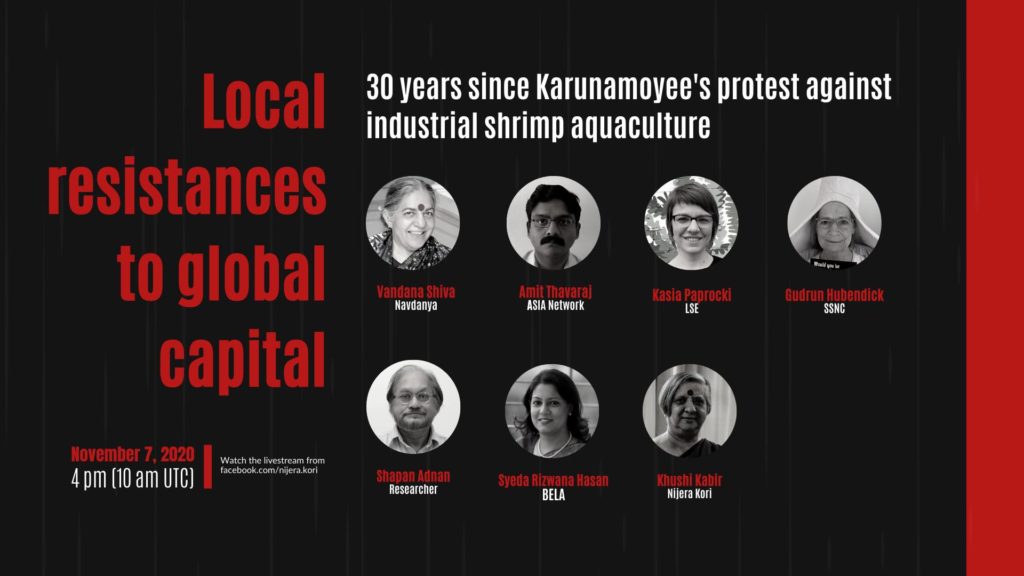 GLOBAL - Karunamoyee Sarder, a landless widow from Bigardana village in Polder 22 of Khulna, Bangladesh, was murdered on November 7, 1990. Along with her fellow villagers, Karunamoyee was leading a procession against the forceful and illegal establishment of shrimp farms in the polder. Industrial shrimp aquaculture rapidly expanded in coastal Bangladesh in the mid-eighties, despite widespread evidence that it brought with it severe socioeconomic and environmental impacts, affecting the livelihoods, job security and access to land of local communities. In Bangladesh, the industry also entailed severe human rights violations, including murder and rape. Commemorating the thirtieth death anniversary of Karunamoyee, this seminar brings together activists and scholars from across the world who have first-hand experience of how the industry has affected communities in Asian and Latin American countries. They will speak of not only the history of the movement in Bangladesh, but put the events in a global perspective, exploring both past and contemporary issues. Through this programme, Bangladesh also launches the One Billion Rising 2021 campaign—the theme this year being to reclaim planet Earth from the plunder it has faced and to resist until violence against women and nature stops. READ MORE Pause before you Plant  GLOBAL - Despite the terrifying recent fires in Australia, California and Brazil there are grounds for hope that the world could finally start valuing its forests. Many governments now say they love trees. There is an increasing international effort to slow rates of forest decline and restore forests where they once stood. Seventy-six world leaders have just signed the Leaders Pledge for Nature, committing to reversing biodiversity loss by 2030, including the restoration of a significant share of degraded ecosystems. As we approach the United Nations Summit on Biodiversity, this shows the international community may be willing to chart a new direction in environmental decision-making. It follows several other international restoration initiatives, such as the Bonn Challenge to restore 350 million hectares of lost and degraded habitat over the next 10 years and calls for mass planting such as the Trillion Tree Campaign. This new political discourse on the importance of trees is welcome. It reflects a growing understanding that forests are essential for our future. READ MORE In mangrove restoration, bespoke solutions trump one-size-fits-all approach  GLOBAL - The vast tangled mangrove forests that sweep along so many tropical coasts are one of the world’s most biodiverse ecosystems. They also play crucial roles in protecting coastlines from erosion and providing communities with resources from food to firewood, and are one of our most effective carbon sinks. Yet they continue to be destroyed and degraded. In their Global Forest Resources Assessment (FRA) for 2020, the Food and Agriculture Organization of the United Nations (FAO) estimated the loss of 1.04 million hectares (2.57 million acres) over the last 30 years. However, there is some cause for some optimism. According to figures from the FRA, the rate of global mangrove loss has more than halved over three decades, from 46,700 ha (115,400 acres) of loss per year between 1990 and 2000, to 21,200 ha (52,400 acres) per year between 2010 and 2020. However, not all regions have experienced a reduction in mangrove deforestation. The FRA found that in Asia, there has been a huge increase in mangrove loss: from 1,030 ha (2,550 acres) per year to 38,200 ha (94,400 acres) over the same 30-year period. READ MORE AFRICA Mangrove forests act as sinks for plastic waste  ARABIAN GULF - The Red Sea and Arabian Gulf surface waters hold smaller volumes of plastic litter than what originally entered them. In a new study, international researchers, including from from Saudi Arabia, have found the reason for this discrepancy: mangrove forests have been sequestering substantial loads of plastic since its mass production began in the 1950s. “Conserving mangrove forests is key to avoiding the resuspension of buried plastic into the water column where they could affect marine organisms,” says the study’s lead author, Cecilia Martin, a marine scientist from King Abdullah University of Science and Technology, Saudi Arabia. Mangrove plant aerial roots and branches trap plastic items brought in by ocean currents, where they fragment into less buoyant, smaller particles. Microorganisms colonising the particles make them heavier, rapidly sinking them, where they eventually deposit in the sediment. The scientists had analysed plastic pieces extracted from dated mangrove sediments and found small fragments and films that probably came from bottles, food wraps and ropes. They also found that plastic concentration decreased from the surface to the deeper layers of the sediments. They conclude that plastic burial rates in marine sediment have risen exponentially since the 1950s, at a rate of 8.5 per cent each year, in line with the rise in global plastic production. The researchers predict burial rates will rise to 7 to 20 times higher than the present rates by 2050. READ MORE AMERICAS Education and Monitoring Programs with Cayman Islands Mangrove Rangers  CAYMAN ISLANDS - The Cayman Islands Mangrove Rangers swung into full action this fall with a variety of programs. In addition to a video series for teachers entitled ‘Creature Features’ focusing on the inhabitants and dependents of Grand Cayman’s threatened Central Mangrove ecosystem, the rangers implemented several projects. Central to these was the problem of illegal cement dumping which has been a perennial problem in Grand Cayman. Caught in the act, National Concrete cleaned up the dump and is being prosecuted under the Litter Law. Following this violation, the rangers have begun a survey of similar mangrove concrete dumps around the island and will post details of these online. Education programs also included a mangrove field trip for 60 Year 2 school kids from Cayman International School to mangroves close by the school. The field visit was followed by science class presentations to Year 10 and 11 students by Mangrove Action Project’s education director Martin Keeley. Also in October, a ranger-led ecotour of the Central Mangroves included members of the student group ‘Protect Our Future’, teachers and local media. Similar school and public education programs are planned for the rest of the year. Watch episodes of 'Creature Features' here. The female guardians of Venezuela’s Imataca Forest Reserve VENEZUELA - It is around five in the morning, and the Imataca Forest Reserve is stirring with the voices of Kariña women. They advance towards the middle of the jungle, bound for the Botanamo river to gather the day’s water. Then, these indigenous women will prepare “casabe”, a circular tortilla made from cassava flour, to accompany what other members of the tribe have brought in from the hunt. After breakfast they turn to their main task of the day: managing and conserving the forest. “I have never seen my indigenous sisters so motivated, so encouraged by their work… Even with all the problems that our country is going through, these women have the initiative to better their own community,” says Cecilia Rivas, the group’s “captain”. “Captain” signifies the community’s elected leader. “The Kariña group was always dominated by men. We had neither voice nor vote before,” she explains. Cecilia’s election in 2013 marked the beginning of a transformation. READ MORE ASIA Neykurendhoo Mangrove An overview 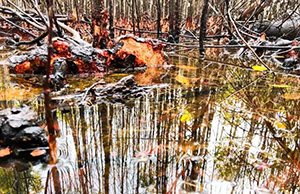 MALDIVES - Situated in the Northern most administrative division of Maldives, Neykurendhoo has the largest known mangrove in an inhabited island of the country. The majority of the islanders depend on tourism and fishery as their main source of income, however the islanders living within the island depend on agriculture for their daily needs as well as to generate income though the sale of their produce to the capital Male’ as well as nearby islands. The main crops produced by farmers in Neykurendhoo include bananas, coconuts, chilies and breadfruits. Groundwater is being used for agriculture as well as household purposes. The island freshwater lens is well maintained probably due to the mangrove/wetland. Residents of Neykurendhoo began to discover the status of the prized wetlands when they ventured into the area to collect mangroves for Ramadan (around April) in 2020. The wetland of Neykurendhoo, is among the largest in the country. The most prominent mangrove in the area is the small-leafed orange mangrove, locally called kan'doo (Bruguiera cylindrical). Residents of Neykurendhoo grew up by sourcing food from these trees. The area has been plagued by an unknown phenomenon since March, leaving the trees yellowed and dried up. READ MORE India’s CUSAT assists Maldives EPA probe cause of mangrove die-off  MALDIVES - Environmental Protection Agency (EPA) is being assisted by the Cochin University of Science and Technology (CUSAT) of India to determine the cause of the die-off of mangroves in several Maldivian islands. The large-scale die-off of mangroves in Maldives came to attention back in March. The first cases were reported from H. A. Kelaa and H. Dh. Neykurendhoo. The phenomenon has since been reported from 11 islands, including Sh. Feydhoo, H. A. Uligan, and G. Dh. Hoadedhoo. Authorities conducted field surveys to determine the cause of the phenomenon in Kelaa and Neykurendhoo, but have yet to publish the findings. Maldives is home to 15 mangrove species, including the rare bruguiera hainesii species, one of the two critically endangered mangrove species listed in the IUCN Red List of Threatened Species. The rare mangrove species was discovered from Kelaa in March. READ MORE Ban GCM for claiming ownership of our coal  BANGLADESH - A controversial energy company, forced to wind down most of its operations and exposure in Bangladesh following a popular opposition from the local population, is now claiming Phulbari's coal deposits as their resources. On October 15, the company, GCM Resources PLC, announced that it signed a framework agreement with China Nonferrous Metal Industry's Foreign Engineering and Construction Co., Ltd (otherwise known as NFC) and Power Construction Corporation of China, Ltd (PowerChina) in relation to its world-class 572 million tonnes (JORC 2004 compliant) of high-grade coal resources at the Phulbari Coal and Power Project in northwest Bangladesh. GCM in the past used to say it had "identified a high-quality coal resource of 572 million tonnes at the Phulbari Coal and Power Project in Bangladesh". The JORC Code provides minimum standards for public reporting to ensure that investors have all the information they would reasonably require for forming a reliable opinion on the results and estimates being reported. As GCM Resources PLC is an AIM-quoted mining and energy company, these announcements are regulatory requirements. AIM is the Alternative Investment Market of London Stock Exchange (LSE) where listings of companies give them opportunities to raise funds. In the two weeks since the announcement, there has been increased trading activities involving GCM shares and at least thrice they had to announce Price Monitoring Extension to extend the auction call period. Auction call extensions give electronic order book users a further opportunity to review the prices and sizes of orders before the execution occurs. READ MORE AUDIO FEATURE Conservation Heroes Welcome to Conservation Heroes, the heroes of this show are the dolphins, bats, otters, mangroves, newts and many others who are protecting our environment right now. This show will look at different laws, guidelines, or policies and will also offer you some top tips to help you protect our planet and even become a conservation hero yourself. Episodes contain interviews from scientists, academics, lawyers, environmental activists and more. The guest for this episode is Dominic Wodehouse, from Mangrove Action Project, in joining us from Manila to talk to us all about Mangroves LISTEN NOW VIDEO FEATURE Commemorating the thirtieth death anniversary of Karunamoyee and the movement against commercial shrimp aquaculture in Bangladesh, this seminar brings together distinguished activists and scholars from across the world who have first-hand experience of how the industry has affected communities in Asian and Latin American countries. They will speak of not only the history of the movement in Bangladesh, but put the events in a global perspective, exploring both past and contemporary issues. Join us on on November 7, 10 am UTC, here The event is organised by Nijera Kori, One Billion Rising, Asia Solidarity against Industrial Aquaculture (ASIA), Navdanya, and the London School of Economics Social Life of Climate Change initiative. Thanks a lot -- Khushi Kabir Coordinator Nijera Kori |
ACTION ALERTSOur Paradise and Sovereignty under Siege - Protect Grenada from Destructive Development! SIGN THE PETITIONStop the destruction of Can Gio Mangrove Biosphere Reserve
|
|
Mangrove Action Project Click here to view past newsletters
|
|
-
The community of adults and youth in Cayman Islands has come together recently to release a series of educational videos. Each is geared to...
-
By Alfredo Quarto, Program & Policy Director Co-founder, MAP There is a rather urgent situation concerning the bio-invasion of the Son...
-
By: Isabel Robinson, MAP Volunteer Intern Some months ago I decided to come to Thailand and do an internship in mangrove conservation, ...
MAP News Issue #595 - April 6, 2024
Push to restore Philippines' mangroves at risk from salt farm law PHILIPPINES - Along the flood-prone coasts of the Philippines, one o...


